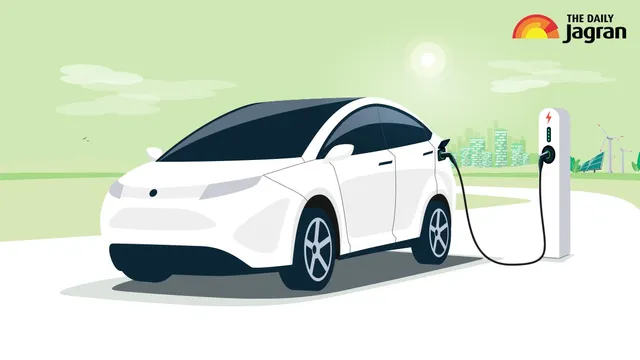- By Arjit Garg
- Fri, 30 May 2025 12:47 PM (IST)
- Source:JND
Over 300 million vehicles are expected to be on India's roads in the coming years, and electric vehicles (EVs) are set to play a significant role in this landscape. However, India's EV journey requires a fundamental shift in infrastructure. 'We cannot drive the future of mobility with the infrastructure of the past.' This truth underscores the need for a complete transformation of our transportation system.
The transition to electric mobility goes beyond replacing petrol pumps with charging stations. It demands a robust, efficient charging infrastructure that can support widespread EV adoption, even in smaller towns. Imagine electric vehicles moving seamlessly through Tier 2 cities without range anxiety – that's the vision we need to work towards.
The Infrastructure Imperative: More Than Just Chargers
As we push for electric vehicles (EVs) in India, we often focus on building public chargers. But it's more complex than just installing fast chargers everywhere. We need a charging ecosystem that's adaptable, efficient, and tailored to India's unique mobility landscape.
Two- and three-wheelers dominate Indian roads, making up over 70% of our mobility. We can't just copy Western infrastructure models; we need solutions that fit our specific needs. That's where innovative ideas like battery swapping stations come in – they're not just convenient but game-changers.
By separating battery ownership from vehicle ownership, commercial users can reduce operational costs and downtime. When one switched to battery swapping, they noticed a significant difference. It's experiences like these that show us the way forward – towards a more sustainable, efficient, and practical EV ecosystem for India.
Manufacturing: Built for India, by India
India's electric vehicle (EV) story is unfolding differently than expected. Instead of large-scale factories driving the change, it's the demand from smaller cities, local transport businesses, and delivery operators that's pushing the industry forward.
This shift calls for a new approach – one that's centered on frugal engineering and micro-manufacturing. Imagine small, decentralized factories that cater to local needs, reduce transportation costs, and allow for faster design iterations.
For instance, setting up a small assembly unit in a Tier 2 city can make a big difference. By sourcing components locally and assembling vehicles on-site, we can cut costs and create vehicles that are tailored to local road conditions. This approach isn't just about saving money; it's about building a more resilient industry that's less dependent on global supply chains.
Rethinking the Battery Equation
Batteries are the most expensive component of an EV, and their pricing, availability, and energy density directly affect affordability and performance. One innovative solution is battery-as-a-service (BaaS) models. Imagine a delivery partner in Bengaluru who can swap out batteries at a nearby kiosk, ensuring their vehicle is always ready to hit the road without the burden of battery ownership.
Swappable battery networks, coupled with intelligent fleet analytics, allow operators to optimize range, charging time, and route efficiency. Moreover, second-life battery applications – such as stationary energy storage – can further reduce lifecycle costs and environmental impact. Policy support for battery recycling, standardization of battery formats, and incentives for indigenous cell manufacturing will be vital in making EVs not just affordable but sustainable.
The Role of Policy and Partnerships
Government schemes like FAME II and state-level EV policies have laid the groundwork. However, the next phase of growth will depend on targeted interventions. These include grid integration strategies that encourage renewable-powered charging stations, priority lending mechanisms for EV loans in semi-urban markets, and incentives for vehicle makers who achieve high localization percentages.
Public-private partnerships to build shared infrastructure can also accelerate adoption. For instance, public fleet electrification – covering public transport, municipal vehicles, and delivery fleets – can serve as a launchpad for mass adoption. When the state becomes an early adopter, it signals market confidence and creates demand pull for supporting infrastructure.
Unlocking the Next Frontier: Tier 2 and Beyond
India's electric vehicle (EV) revolution is set to unfold in its smaller towns and cities. These areas are often overlooked, but they're where the real growth will happen. People here are practical and budget-conscious, looking for vehicles that can withstand rough roads and save them money on fuel.
For delivery partners, autorickshaw drivers, and rural entrepreneurs, EVs can be a game-changer. What they need are vehicles that are tough, easy to repair, and affordable. Purpose-built EVs designed specifically for these users can make a huge difference.
By building EVs in India, using local supply chains, and simplifying production, we can create vehicles that truly meet the needs of these communities. It's about making EVs accessible, reliable, and economically viable for the people who need them most.
From Vision to Vehicle
Scaling EV adoption in India is not a linear journey – it’s an ecosystem challenge that demands innovation across the value chain. As we chart the future of EVs in India, it won’t just be the corporate boardrooms calling the shots. It will be co-created with mechanics in Madurai, fleet operators in Kanpur, and delivery riders in Guwahati.
Only when infrastructure meets innovation at every level – from design to deployment – can India truly electrify its mobility future. The future of EVs in India is not about replicating global models; it’s about reimagining what mobility means for India.
Disclaimer: This article is authored by Bharat Polturi, CEO & Co-founder, Emobi. All views are personal.

